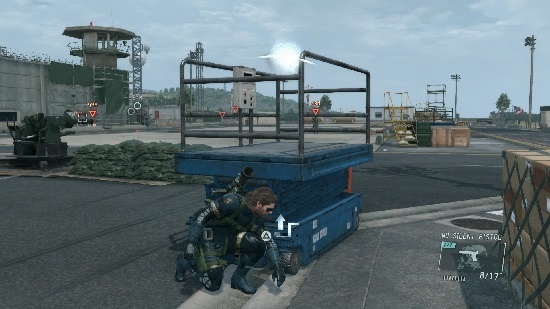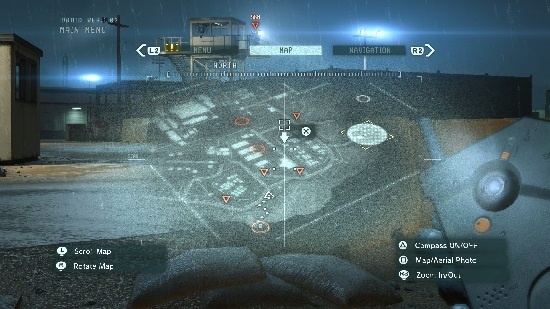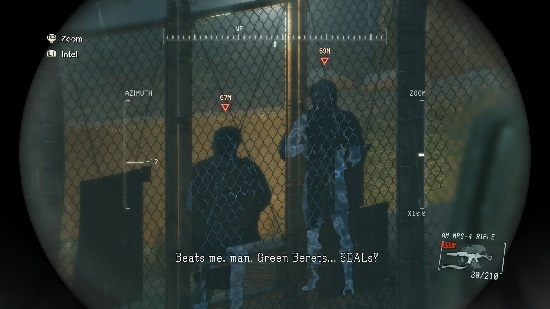Ground Zeroes sold me on The Phantom Pain.
Developer: Kojima Productions | Publisher: Konami | Released: March 18, 2014
Available on: PS3, PS4, Xbox 360, Xbox One | Time Played: 5 hours
By now you’ve almost certainly heard how short Ground Zeroes is.
What people say about the length is no exaggeration: if you play exclusively for the main story, which threads the PSP release Peace Walker into the upcoming The Phantom Pain, you will probably be finished in an hour. That’s even if you play imperfectly and have to retry a bit, which you probably will your first time out. Enough has changed from previous Metal Gear titles that even veterans will need to get acclimated to some of the new tools and features at Snake’s disposal. But that hour will be mostly gameplay; for a Metal Gear title, there is remarkably little time spent in cutscenes. Furthermore, there is a lot more to do than just the main story, and the gameplay is strong enough – which is to say, pretty strong – that it’s worth doing.
Ground Zeroes sees Snake – aka Big Boss – infiltrating a US Marine prison camp in Cuba to rescue Chico, a member of his mercenary organization Militaires Sans Frontieres, in 1975. Chico and the MSF are elements from Peace Walker, but for the most part you can get by without having played that game. The base is sprawling and open, and there are multiple ways to reach objectives and, often, secrets to discover elsewhere. This mission is bookended by the game’s main cutscenes, which are more or less what you’d expect from a Metal Gear Solid game.
Gameplay resembles that of Guns of the Patriots, well-tuned and responsive third-person sneaking and, when need be, shooting, and for better or worse it is possible to shoot your way through most missions. Still, the game encourages stealth, which awards higher scores and greater rewards. Stealth is at once trickier and more engaging than before; completely gone is the radar and vision cone system that previous games struggled with replacing, so situational awareness is important. However, Snake is helped along by the fact he can mark enemies with his binoculars, which grants some ability to track them as they move. This functions well to not only help players make up for the lack of a radar, but encourages planning ahead and taking stock of the situation before moving. If an enemy does spot Snake, the game goes into slow motion, and he has a few seconds to react. Overall, it’s a solid evolution of the series’s existing systems; I always felt like I had the tools I needed, if not always the patience and skill to utilize them appropriately.
So the question really becomes, how little game is too little? Well, the thing is, it’s not that Ground Zeroes lacks for content. Considering its budget price – $30 for the PS4, less for a digital copy on the PS3 – the AAA production values are exceptional. Detailed character models, well-done animation, smooth systems – you wouldn’t expect to see this kind of power in a title that released for that price. But more importantly, Ground Zeroes isn’t really that tiny, all things considered; it just defies existing expectations for what a Metal Gear Solid game is supposed to be, but length aside that’s a really good thing.
Metal Gear Solid has always been a series that thrives on its story-driven gameplay. Though titles at least as far back as Metal Gear Solid 2 have tried to add additional score-chasing gameplay through “VR missions,” they’ve always fallen short of being very compelling. For the most part, the games have been done once the plot is finished, unless you want to play them again for various unlockables and secrets. Ground Zeroes is the antithesis of this, focusing instead on creating a compelling gameplay framework and playing field to encourage repeated, exploratory play. The story really only does enough to justify the game’s existence within the series – fans would be disappointed in a Metal Gear Solid title with no story at all – and then steps back to let players engage with the tactical espionage action playground of Camp Omega.
As Kojima said, this is one for the players who enjoy vying for higher scores and faster runs, and in that capacity there are enough moving parts and side objectives to make that compelling for a little while. Completed your mission? Do it faster. Without being spotted. Complete a side objective, kill fewer enemies, rescue more prisoners. If Metal Gear Solid‘s gameplay is your cup of tea, Ground Zeroes offers a more repeatable experience that previous games lacked.
More relevantly, though, Ground Zeroes sold me on The Phantom Pain.
Now, let’s be honest, I’m one of those guys who was waiting outside his local GameStop when they unlocked the doors the day Guns of the Patriots came out, knocked it out by the next day, and then played it the fuck again. Short of some catastrophe, I was going to be buying The Phantom Pain. But one of the concepts in the “true” Metal Gear Solid V that I wasn’t sure about was its open-worldness. Some of this comes from my misgivings about open-world gameplay in general; I think it’s overused and most open-world games feel like they don’t offer enough varied gameplay to justify being open-world to me.
Specifically, of course, Metal Gear Solid has always thrived on its narrative thrust, and often one of the consequences of that has been a tight but fairly linear level design scheme, even though each successive title since Snake Eater has made some efforts at being more open. My concerns with The Phantom Pain were twofold: one, that the gameplay would get lost in the concept, becoming something more like Guns of the Patriots with a bigger environment, more shooting and less stealth; and two, that the story would compete with the amount of gameplay the open-world would imply.
Ground Zeroes thoroughly proves to me that Kojima’s team is up to the task of delivering the gameplay experience I’d want The Phantom Pain to be. Camp Omega is essentially a small open world, and it is easy to sit back and imagine it being one location on a larger map, with its entry points not exiting the mission but simply going to the world. There are vehicles to drive around, and though you don’t really need them to get around the camp, their mechanics are likely hints of vehicular travel to come, and they handle nicely, solid and believably heavy in the case of the big military transport trucks. There’s even some hint that some of the mechanics from Portable Ops and Peace Walker may make a return, with Snake being able to rescue prisoners by loading them into the exfil helicopter or the back of a jeep to drive away, but that’s just conjecture on my part.
Whether or not a Metal Gear Solid story can exist alongside an open-world game is still something of an open question, but Ground Zeroes does suggest that maybe Kojima has learned something about the balance from Guns of the Patriots. I still expect there will be a lot of cutscenes in The Phantom Pain, but I am optimistic that the ratio will not be two hours of cutscene to every one of gameplay again.
So I really like Ground Zeroes. But how much content do we demand from a AAA release? If it were full price it would be a massive letdown, but it isn’t; at the same time, it feels meatier and more final than a demo would, with its replayability and, presumably, content unique to it that won’t be repeated in The Phantom Pain (although at least one major story beat will have to at least be synopsized). Honestly, I think there’s room in this commercial space for smaller, lower-priced games, distributed standalone digitally and through retail; Ground Zeroes is not the first, though it’s probably the highest profile in recent memory. They sit in a weird nether realm between DLC and old-school expansion pack, where the perception of value for money is kind of all over the place.
If I have one real, actual complaint, it’s that I’m not sold on Kiefer Sutherland as Snake. He does a good job – he is objectively better than classic Snake voice actor David Hayter, I suppose – and he doesn’t deviate too wildly from what Snake is supposed to sound like. Still, there’s something just a little too…believable about it. In the hyperrealistic world of Metal Gear Solid, Snake’s excessive gruffness holds a certain charm in addition to its familiarity. But then, I am notoriously resistant to voice actor change; my chief complaint about Arkham Origins had to do with the recasting of both Batman and the Joker, despite being performed by extremely competent actors, and I will probably never forgive the Transformers movies for not giving Frank Welker the part of Megatron. (Then again, there’s a lot those movies have to answer for.)
Ground Zeroes does not pretend to be something other than a bone thrown to fans. It is that. And maybe it’s a test run for some of the paradigm shift Kojima has planned for The Phantom Pain. Consequently, it’s not the must-play that a fuller featured Metal Gear Solid might’ve been, and it remains to be seen if it’s even that important to The Phantom Pain (my guess, narratively, it’s more of a teaser than an integral part of the story). But for the right price (whatever that means to you) it’s a nice diversion, and a nice taste of what’s to come.
![]() To contact the author, tune your codec to dix@tap-repeatedly.com!
To contact the author, tune your codec to dix@tap-repeatedly.com!





I’ve never played a Metal Gear title – one of the larger gaps in my gaming experience, really – and stuff like this really intrigues me. But I think most of the relevant games are available in compilations these days. Maybe I should set aside some catch-up time.
Storied franchises like this might do well to follow the same mold we see here, which is to say smaller, shorter in-between games sold at a lower price (though for an hour of main story, $30 still seems high production values or no). It allows the design team to test out new ideas without using their AAA sequels as guinea pigs, keeps fans sated between those major sequels, and could lure new fans into narrative games more easily.
Well, and it would be erroneous to really call Ground Zeroes a “narrative” game. Both Konami’s statements about it and most all the features within it speak to pulling people into the gameplay, and there just happens to be some intermediate plot because that’s what people expect (and they can drop a cliffhanger on us).
Ground Zeroes is clearly not the place to start, but I feel like it’s hard to take a solid perspective on AAA development without Metal Gear Solid. In the original game was so groundbreaking for “cinematic” experiences, and these days I’d probably maintain that Metal Gear Solid 3: Snake Eater is one of the best titles of the PS2/Xbox generation. MGS epitomizes both the good and bad of game storytelling (at least in the AAA sphere) to this point, and I think that’s why most people have sort of a love-hate relationship with it. I could probably go on and on about it. Maybe someday I will.
Considering this game, I did spend a little time thinking about where expansions have gone. I haven’t quite collated my thoughts into much coherent, but expansions have fallen by the wayside since the golden age of PC gaming – and for a while that was because you couldn’t really do a console expansion, but then when DLC became a regular thing expansions didn’t really resume like I (and others, I expect) sort of thought they would. DLC is invariably much smaller than what we used to call “expansions,” with one or two exceptions. But I think maybe it’s our fault. I seem to recall people pitching a fit about Dragon Age Origins: Awakening when it released as a “standalone expansion”, despite being less-than-full price and despite being, from the best of my recollection, 15-20 hours of content in a new region with new characters. That may have had something to do with EA having lost a lot of credibility with the ham-fisted Day One DLC that Dragon Age had in it.
We are seeing more variability in both game prices and sizes, as we sort of once did back in the 90s, although then it was more a function of cartridge hardware, not someone intentionally pricing a game less because they knew it was smaller. But even now that seems to be a lot more about whether the game’s independent or AAA.
It’s weird. In retrospect I just have this sense of a legacy of the vocal gaming consumer complaining about the price of new games being too high, but then complaining about being gouged for more money when a smaller but cheaper game in the same series comes out.
So this was a PS+ title the month before last and I’ve been very slowly working my way through it between sessions of Bloodborne. It is my first ever Metal Gear (I never even played the original on the NES) so you can imagine that there’s quite an experience curve, from controls to story. Despite the fact that I have no clue what’s happening, it has done a good job of selling me on The Phantom Pain too. I’ll be even more lost (did you know that a Metal Gear is actually, like, a thing you have and not just a term? I didn’t!), but I have a feeling it’ll be a fun sort of lost.
I also didn’t know that Snake is different from Solid Snake. And… both of them are Big Boss? I’m so confused. Does Snake have a real name, like Fred or Lamar or something? Or did his Mom actually name him “Snake?” Wait…. Does he have a Mom? The YouTube summary video was distressingly unclear on many such points.
I should’ve thought about doing a Metal Gear primer for MGSV…but it didn’t occur to me. As Metal Gear games go, though, Phantom Pain is one of the least mired in continuity.
The short version to answer your questions is: Naked Snake was Big Boss’s first codename as far as the games are concerned. His real name is John. After MGS3, he started going by Big Boss because reasons. He founded a private military company called the MSF, in hopes of someday founding a “nation for soldiers.” This is when characters from Ground Zeroes come in: Chico joins up, and Paz joins, too, but as a double agent for Cipher, a shadowy intelligence branch who is the primary villain in Peace Walker and Phantom Pain. This is also the time when he meets Kazuhira Miller, who shares his vision and talks to him on the radio mostly.
Solid Snake is an eventual clone of Big Boss. His “real” name is David, but he doesn’t have a mother in the normal sense, exactly. That part’s complicated. Solid Snake eventually defeats Big Boss when Big Boss actually manages to create “nations for soldiers” in the original two Metal Gear games on the NES.
Most of the continuity Phantom Pain is concerned with is from Peace Walker, which was very good but was also on the PSP, so only five people played it.
Amazon Points FTW, I now have The Phantom Pain. First thing it did: crash my PS4 so hard I thought it had broken the console. Bad way to start, but forgiven now.
And then things got weird. Why did no one tell me about the weird?
This is like freaking War Day if David Lynch directed it.